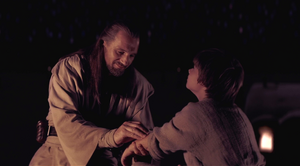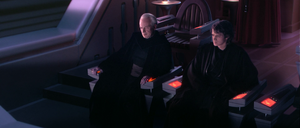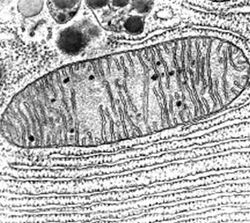| | |
Warning: The following parameters in the infobox are unrecognized: members
- "Without the midi-chlorians, life could not exist, and we would have no knowledge of the Force. They continually speak to us, telling us the will of the Force. When you learn to quiet your mind, you'll hear them speaking to you."
- ―Qui-Gon Jinn, to Anakin Skywalker
Midi-chlorians were microscopic, intelligent life forms that originated from the foundation of life in the center of the galaxy, and ultimately resided within the cells of all living organisms, thereby forming a symbiotic relationship with their hosts. The Force spoke through the midi-chlorians, allowing certain beings to use the Force if they were sensitive enough to its powers. In order to gauge an individual's potential in the Force, blood tests were used to estimate the number of midi-chlorians within the subject's cells. Anakin Skywalker, the Chosen One, possessed the highest known count in galactic history—over 20,000 midi-chlorians—surpassing the potential of all the Jedi including Grand Master Yoda.
Biology
- "Midi-chlorians are a microscopic life form that resides within all living cells."
- ―Qui-Gon Jinn, to Anakin Skywalker

Qui-Gon Jinn believed that the Chosen One, Anakin Skywalker, was conceived by the midi-chlorians.
Midi-chlorian was the scientific name[2] for a species of sentient and microscopic organisms that inhabited the cells of every life form.[1] Their existence was integral to the all-encompassing energy field known as the Force, connecting the Living Force to the Cosmic Force.[3] By serving as the link between the living and cosmic aspects of the Force, the midi-chlorians made it possible to preserve an individual's consciousness after death. With sufficient training[4] and total immersion in the light side of the Force,[5] the deceased could preserve their identity in the form of a Force spirit after becoming one with the Force.[4]
In addition to their connection with the Force, midi-chlorians lived in a symbiotic relationship with their organic hosts—a bond that was especially strong with Force-sensitive beings, who possessed a high quantity of midi-chlorians in their cells. This mutually advantageous relationship allowed the midi-chlorians to communicate the will of the Force to their Force-sensitive symbionts, who were capable of utilizing the powers of the Force through the midi-chlorians.[1]
Study and analysis
- "I need a midi-chlorian count."
"The readings are off the chart. Over 20,000. Even Master Yoda doesn't have a midi-chlorian count that high."
"No Jedi has." - ―Qui-Gon Jinn and Obi-Wan Kenobi

Blood samples were analyzed to estimate the number of midi-chlorians in a person.
Midi-chlorians were detected through a scientific analysis of blood samples taken from a life form. In this case, the purpose of examining blood was to calculate the number of midi-chlorians that resided within the living cells of a subject, and therefore, determine the natural strength of the connection between said subject and the Force. By 32 BBY, thirty-two years before the Battle of Yavin, the highest known concentration of midi-chlorians in a life form was approximately twenty-thousand according to Jedi records. This record was broken following the discovery of Anakin Skywalker in the same year.[1]
History
Origin
- "What is this place?"
"All that surround us is the foundation of life, the birthplace of what your science calls midi-chlorians, the foundation of what connects the Living Force and the Cosmic Force." - ―Yoda and Serenity
The Wellspring of Life was the birthplace of the midi-chlorians.
The Wellspring of Life, a mystical world located in the heart of the galaxy, was the birthplace of a microscopic species that served as the link between the Living Force[3] within all life forms and the infinite Cosmic Force.[6] It was also the foundation of life,[3] with all life forms serving a symbiotic host for the living organisms[1] native to the wellspring.[3] In modern science these intelligent microbes became known as "midi-chlorians."[7]
The existence of midi-chlorians was known to both the Jedi[1] and the Sith.[8] The Jedi Order utilized the scientific procedure of blood testing to estimate the number of midi-chlorians within prospective initiates. In addition to their scientific knowledge of midi-chlorians, Jedi philosophy held that the midi-chlorians were the foundation of all life itself, and therefore life could not exist without the midi-chlorians.[1]
The Chosen One
- "His cells have the highest concentration of midi-chlorians I've ever seen in a life form. It's possible he was conceived by the midi-chlorians."
"You refer to the prophecy of the one who will bring balance to the Force. You believe it's this…boy?" - ―Qui-Gon Jinn and Mace Windu

To her astonishment, Shmi Skywalker conceived a son who had no father.
In 32 BBY, Jedi Master Qui-Gon Jinn encountered Anakin Skywalker, a human child with an exceptionally powerful connection to the Force, but enslaved on the desert world of Tatooine. Intrigued by Anakin's natural strength, Jinn's fascination grew when the boy's mother, Shmi Skywalker, revealed that her son was born without a biological father.[1][9] Later, a blood test confirmed that Anakin possessed a midi-chlorian count that exceeded twenty-thousand—the highest recorded at the time—exceeding those of all Jedi including the powerful Grand Master Yoda. The test results, Anakin's unique conception, and the reemergence of the Sith were all factors that led Jinn to a single conclusion: Anakin Skywalker was the prophesied Chosen One,[1] destined to destroy the Sith[8] and bring balance to the Force.[1]
Anakin Skywalker was ultimately liberated and brought to the Jedi Temple on Coruscant, the capital planet of the Galactic Republic, where he would begin his training with the permission of the Jedi High Council. Jinn disclosed the results of Skywalker's blood test in his report to the Council, as well as his belief that Skywalker may have been conceived by the midi-chlorians. Though initially skeptical of the maverick Jedi Master's claims, the Council ultimately accepted Skywalker into the Order in the aftermath of the Battle of Naboo.[1]
Yoda's journey
- "All energy from the Living Force, from all things that have ever lived, feeds into the Cosmic Force, binding everything and communicating to us through the midi-chlorians."
- ―Qui-Gon Jinn, to Yoda
By 19 BBY, over a decade after the discovery of Anakin Skywalker, the spirit of the late Qui-Gon Jinn made contact with Yoda. After journeying to the planet Dagobah at Jinn's insistence,[4] Yoda discovered the birthplace of the midi-chlorians, where he learned of their role as the link between the Living Force and the Cosmic Force,[2] a connection embodied by five ethereal beings: Anger, Confusion, Joy, Sadness, and Serenity.[6] With their aid, the ancient Jedi Master gained greater insight into the nature of the midi-chlorians, which, in turn, led to his acquisition of a new ability—the power to preserve his consciousness after becoming one with the Force.[5]
The Tragedy of Darth Plagueis the Wise
- "Darth Plagueis was a Dark Lord of the Sith so powerful and so wise, he could use the Force to influence the midi-chlorians to create…life."
- ―Sheev Palpatine, to Anakin Skywalker

Anakin Skywalker learned about Darth Plagueis' knowledge of midi-chlorians from Sheev Palpatine.
In the waning days of the Clone Wars, Skywalker became fearful of losing his secret wife, Senator Padmé Amidala, due to premonitions of her death in childbirth. Darth Sidious, the Dark Lord of the Sith whom Skywalker knew as Supreme Chancellor Sheev Palpatine, sought to lure Skywalker to the dark side of the Force[8] by recounting a so-called Sith legend[10] that involved the midi-chlorians. According to Sidious, Darth Plagueis was a wise and powerful Sith Lord who could manipulate midi-chlorians to create new life, an ability that extended to preserving life from death itself. Ultimately, the Chancellor's story served to motivate Skywalker's betrayal of the Jedi Order, resulting in his fall to the dark side as Darth Vader.[8]
Behind the scenes
Concept and development
- "It is said that certain creatures are born with a higher awareness of the Force than humans. Their brains are different; they have more midi-chlorians in their cells."
- ―George Lucas, establishing guidelines for the Expanded Universe in 1977
Midi-chlorians were first conceived by George Lucas as early as 1977. However, they were not featured in the original trilogy, as Lucas felt there was insufficient time to introduce the concept of midi-chlorians to Star Wars.[11] As a result, midi-chlorians were not mentioned in any Star Wars product until the 1999 film Star Wars: Episode I The Phantom Menace, where they revealed why some characters possessed an inherent sensitivity to the Force that others lacked, an issue which Lucas had left unresolved since the original film Star Wars: Episode IV A New Hope. Lucas incorporated the explanation of midi-chlorians into the film as part of Anakin Skywalker's journey towards understanding the Force.[12] Prior to that, however, Lucas implied that the precepts of being a Jedi could be practiced by "anyone" when discussing the story treatment for 1983's Star Wars: Episode VI Return of the Jedi in 1981 (then titled Revenge of the Jedi), and in particular the backstory for Anakin (who had been revealed to be Darth Vader), comparing it to yoga or karate.[13] As recorded in Star Wars: The Making of Episode I The Phantom Menace, the midi-chlorians were incorporated into the film's story in the second screenplay draft, finished around 1995.[14]

The midi-chlorians were inspired by mitochondria.
Midi-chlorians in The Phantom Menace are part of a recurring theme throughout the movie, that of symbiotic relationships.[12] They were loosely based on mitochondria, organelles that provide energy for cells; like midi-chlorians, mitochondria are believed to have once been separate organisms that inhabited living cells and have since become part of them; even now, mitochondria act in some ways as independent lifeforms, with DNA all their own. Lucas established this relation with mitochondria, in particular the necessity of midi-chlorians for life to exist, as a metaphor for society; namely, he says all parts of society must get along in much the way the midi-chlorians and their symbiont do.[15]
In 2006, a newly discovered species of bacteria residing within mitochondria was named Midichloria mitochondrii as a tribute to the midi-chlorians. Nate Lo, its discoverer, wrote to George Lucas requesting permission to use the name and was granted it.[16]
George Lucas' original outline for the sequel trilogy explained that the midi-chlorians served as a conduit between the vessels (who were all the living things) and the Whills, who controlled the Force and were essentially it. When Lucas sold Lucasfilm Ltd. to The Walt Disney Company in 2012, these plans for the sequels were ultimately scrapped. However, Lucas is sure that fans would have hated his idea much like they hated the prequels, though at least the story from the beginning to the end would have been told.[17]
While developing the 2019 film Star Wars: Episode IX The Rise of Skywalker, the final installment of the Star Wars saga as whole, director J.J. Abrams and his crew met with George Lucas to consult him about the movie, which led Lucas to explain them his own ideas about the midi-chlorians.[18]
Controversy
As with other material in The Phantom Menace, the midi-chlorians received some negative reception among Star Wars fans, as some see them as adding hard science to the mystery or spirituality of the Force and dislike what they see as a new concept. Others, however, believe that having a physical aspect to a mystical Force calls upon real-world religious traditions, feeling that the mythic qualities of the Force have been strengthened by midi-chlorians.[19]
A few people felt that this negated the democratic aspect of the Force, as the story and dialogue of Return of the Jedi had made it clear that the Force was, at least in some ways, hereditary, such as when Luke tells Leia that "The Force is strong in my family."[20]
Even people associated with the franchise, such as author James Luceno, felt that the concept robbed the Force of some of its mystery.[21] Steve Perry, who used midi-chlorians in his 2007 Star Wars Legends novel Death Star, opined that they were "less than inspired."[22] George Lucas, on the other hand, considers the two aspects of the Force separately, treating the midi-chlorians as the practical, biological side, distinct from the spiritual and metaphysical side of the Force.[12]
A misconception exists that rather than being indicators, midi-chlorians actually are the Force or create it; there is no canonical basis for this belief.[23][24][25]
Appearances
- Star Wars: Episode I The Phantom Menace (First mentioned)
 Star Wars: The Clone Wars — "Deception" (Mentioned only)
Star Wars: The Clone Wars — "Deception" (Mentioned only) Star Wars: The Clone Wars — "Voices" (Mentioned only)
Star Wars: The Clone Wars — "Voices" (Mentioned only) Star Wars: The Clone Wars — "Destiny" (Mentioned only)
Star Wars: The Clone Wars — "Destiny" (Mentioned only)- Star Wars: Episode III Revenge of the Sith (Mentioned only)
 Star Wars Rebels — "A World Between Worlds" (Indirect mention only)
Star Wars Rebels — "A World Between Worlds" (Indirect mention only)
Non-canon appearances
 LEGO Star Wars: The Freemaker Adventures — "The Lost Treasure of Cloud City" (Mentioned only)
LEGO Star Wars: The Freemaker Adventures — "The Lost Treasure of Cloud City" (Mentioned only) LEGO Star Wars: Droid Tales — "Exit from Endor" (Mentioned only)
LEGO Star Wars: Droid Tales — "Exit from Endor" (Mentioned only)
Sources
 Force planet in the Encyclopedia (content now obsolete; backup link)
Force planet in the Encyclopedia (content now obsolete; backup link) Anakin Skywalker in the Encyclopedia (content now obsolete; backup link)
Anakin Skywalker in the Encyclopedia (content now obsolete; backup link) "Destiny" - The Clone Wars Episode Guide on StarWars.com (backup link (explore/the-clone-wars/ep612/#!/about) not verified!)
"Destiny" - The Clone Wars Episode Guide on StarWars.com (backup link (explore/the-clone-wars/ep612/#!/about) not verified!)- Star Wars: Absolutely Everything You Need to Know
- Darth Vader: Sith Lord
- Star Wars: The Dark Side
- Star Wars: The Secrets of the Jedi
 Force Planet in the Databank (backup link)
Force Planet in the Databank (backup link) The Force in the Databank (backup link)
The Force in the Databank (backup link)
Notes and references
|
